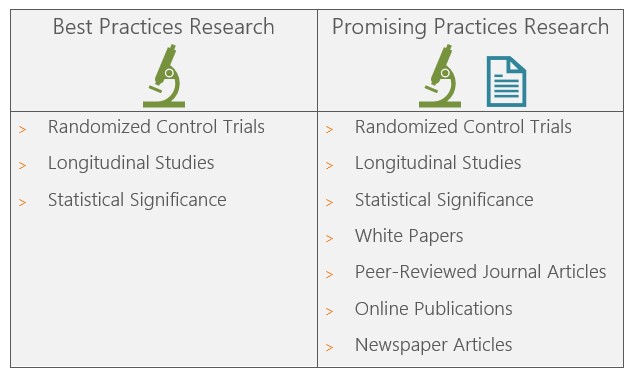What is promising practices research?
11/19/20 / Caitlin McAteer


In a previous blog, “What is Secondary Research,” we highlighted the merits of using existing information to guide decisions. Here, we discuss promising practice research, a form of secondary research, that is more open regarding the rigor and formality of the information that can be used to inform a decision.
The Problem
One application of promising practices research is to guide the design of a new initiative or for developing measures to show the initiative is a success. Here, it is common for organizations that are meeting a specific need to refer to existing information to help inform what a program does and how to define success. This is often referred to as best practices research. For example, an organization could find a program with a randomized control design that demonstrates how differences between a control population and a population that receives an intervention are statistically significant. However, one problem with best practices research is that methodologies, findings, and suggestions likely do not take into consideration the unique needs, culture, context, or backgrounds of your participants or clients because they must be replicated exactly to produce the same outcomes.
The term “best practices” connotes a definitive approach that will produce a certain outcome. A person conducting best practices research may only replicating interventions that have strong evidence of success. Here, more rigor and higher degree of evidence may mean there are fewer examples to choose from for your own intervention. Additionally, the word “best” also implies that there is one best way of going about a thing. Only considering practices deemed “best” may limit your ability to find what might be best for you. For an additional discussion of this concept, we encourage you to visit the Better Evaluation blog “Why There Can’t Be A Best Practice.”
Our Recommendation
For an initiative to last and address unique needs, it must be informed by the research but be tailored to take the implementation context into consideration. Therefore, rather than the term “best practice,” we suggest using “evidence-based.” This term avoids implying that something is universally “best” while still acknowledging that evidence is useful for arguing why a program has been successful and may be successful in other contexts as well. By conducting promising practices research, one can, select, review, and draw from journals, books, newspapers, and other sources, to inform the design of the initiative and evaluation structures. Sources of useful information can range from evidence-based to interventions that are showing promise but still require further study.
By moving past only considering “best” practices, an organization can recognize the power in considering approaches that are showing promise but may not yet have enough evidence of success to be viewed as the gold standard. Alternatively, with a promising practice approach, an organization can take bits and pieces of programs, interventions, and initiatives that may apply to a context to produce something uniquely tailored to a certain need. Although promising practices research may take extra time in the beginning to find possible models that can inform an approach that is right for you, the unique result specific to your context and participant needs pays off in the end.

Every program implementation context is unique, and the initiative design and evaluation should, therefore, be unique as well. The ability to move past best practices to consider a broader definition of evidence that has promise within a unique context allows organizations to look at what may be best for their participants by drawing from secondary sources that can collectively tell a more holistic story. At Corona, we work hard to ensure that our methodologies and design are informed by a wide view of literature and data to ensure that structures are right for the needs of participants. Here, we see program design and evaluation as a matter of balance and program structures should be uniquely built rather than putting emphasis on what is considered “best.”